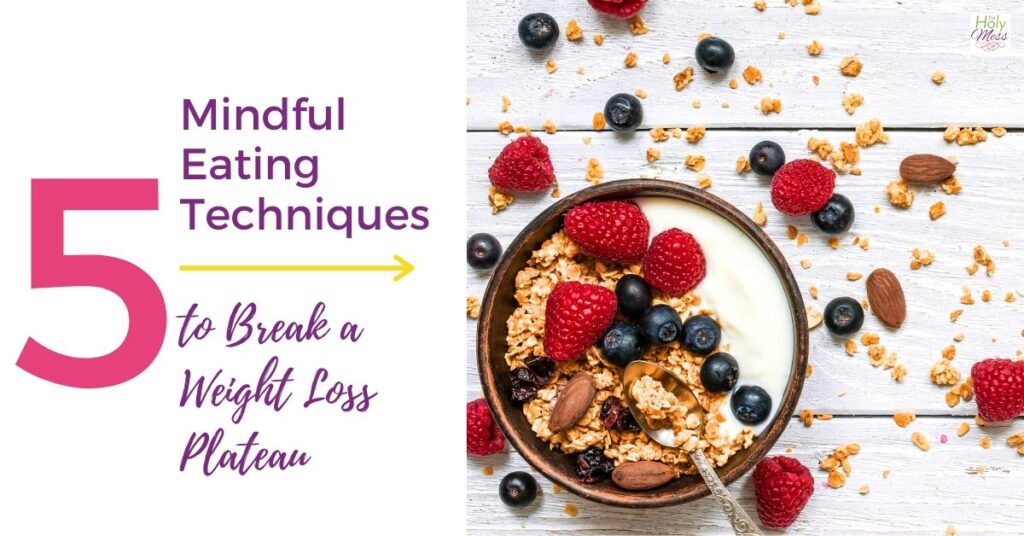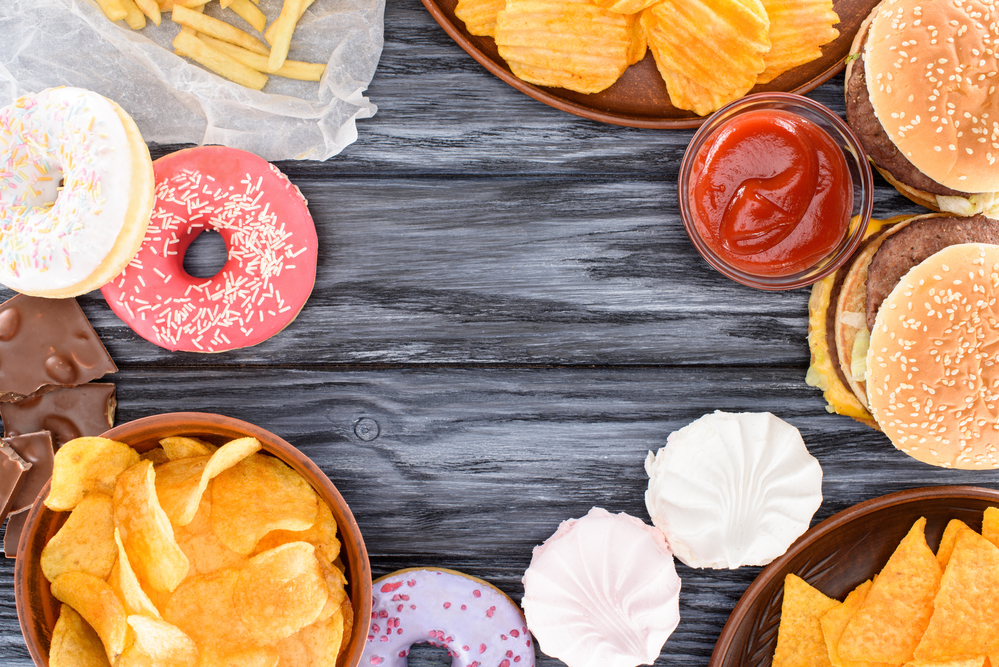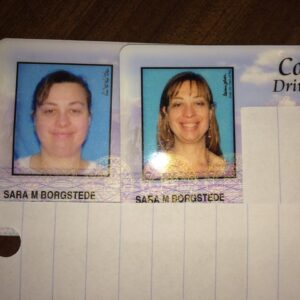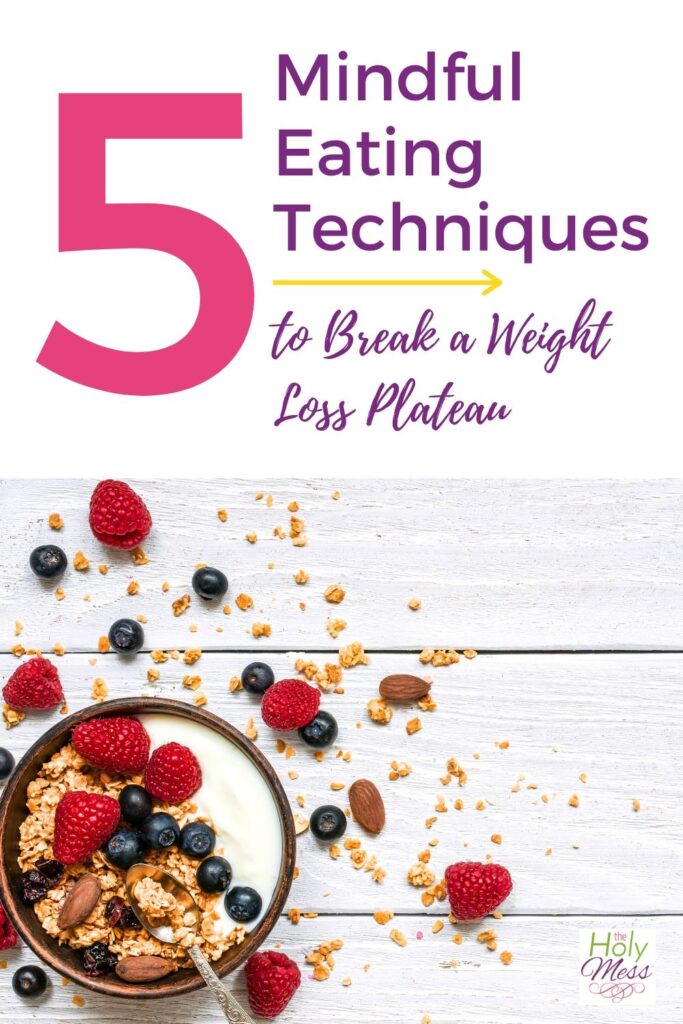Have you wondered how you can incorporate mindful eating techniques into your weight loss process? Maybe you are curious about eating mindfully but you aren’t quite sure how to begin or what it involves.
If you’ve been overweight for much of your life or followed diet programs, the idea of eating mindfully can feel a bit overwhelming and even scary. Let’s dive into what mindful eating is, how it helped me break a years-long weight loss plateau, and specific strategies you can begin to incorporate starting today.

What is Mindful Eating?
Mindful eating is eating consciously, paying attention to the food and your body as you eat. This is an intentional practice that is improved over time. For more information on what mindful eating is and a free printable guide, check out out post with 20 ways to eat more mindfully.
Most of us (even people without weight issues) could do a better job of eating in a more gentle, mindful way. When you pay attention to the food you are eating, you enjoy it more, savor it, and slow down during your day to appreciate the food you are given and the strength it gives your body.
How to Use Mindful Eating to Break a Plateau
Mindful eating is an important technique to use if you are dealing with a weight loss plateau.
Plateaus often involve denial. (For example, you are probably saying to yourself about your plateau, “But I’m not overeating!) Most of us overeat at different times during our day or week or in small ways we don’t recognize.

Face to Face comparison of my 100+ pound weight loss. Many people say I look younger now that I’ve lost weight. I’m actually 15 years older in the photo on the right!
Eating mindfully brings those unhealthy patterns to the surface.
Even though I had been maintaining a 100 pound weight loss for many years, last year I made additional changes that helped me break a 15 year plateau. (yee-haa!) One of those changes was that I started to eat more mindfully.
I admit, I was quite stubborn about this at first. I didn’t want to admit that I was overeating and I figured because I had my tracking and nutrition down, I didn’t “need” mindful eating.
I was wrong.
Overeating – even healthy food or food that is tracked and accounted for – is still overeating. Any type of overeating will push you away from your weight loss goals. Yes, even apples, carrots, or grilled vegetables can be overeaten when it’s more food than your body needs.
What’s the Difference Between Mindful Eating and Intuitive Eating?
While they overlap and have similarities, mindful eating and intuitive eating are two different concepts.
- Mindful Eating means paying attention to the food you eat and your body’s sensations as you eat.
- Intuitive Eating means eating without a diet or food program and trusting your body’s signals to guide your food choices.
Mindful eating is not a specific method but is simply paying attention to your food and body. Mindful eating can be done within any approach or lifestyle.
Intuitive Eating, created by Evelyn Tribole and Elyse Resch, has become increasingly popular in recent years. Their approach involves following 10 guiding principles such as rejecting the diet mentality, honoring your hunger, and making peace with food.
Intuitive eating is a more specific non-diet strategy that involves letting go of all diet parameters and “legalizing” all foods as neither good nor bad. While I think there is much to be learned from their methods, for many people with a history of overeating (me included) jumping straight into their methods is too much freedom.
Mindful eating, however, can be practiced by anyone and is helpful for all of us to improve our relationship with food.

All of us can learn to eat more mindfully, whether following a diet or food plan or not.
Can I Eat Mindfully With WW, Tracking, and Diets?
Is mindful eating possible within a diet or food program like Weight Watchers, Keto, or some other structured system?
Yes!
I absolutely believe you can learn to eat mindfully regardless of the food program you follow.
This topic is near and dear to my heart as a life-long Weight Watchers member who also wants to eat in a more mindful way.
Many people who are proponents of mindful eating, and especially intuitive eating, say you should ditch diets all together. They believe that tracking is bad news and that any outside program will block your body’s ability to guide you in choosing the food you need.
I disagree with the idea that all counting, tracking, and diet programs should be thrown out the window and I can tell you that this wasn’t what worked for me. When I began my weight loss journey I was over 100 pounds overweight. My concept of a healthy amount of food was completely off base.
I used therapy for weight loss and it was the most important factor to my success. I also used the Weight Watchers program because I needed the guided structure.
Today, I run a Christian weight loss program for women called Faithful Finish Lines where we teach women how to eat in a healthy way while keeping God at the center of their journey.
I absolutely believe it’s possible to eat mindfully within a structured program and that is exactly what I do. I count and track. I pre-planned what I will eat the next day, but I also pay attention during each meal or snack and listen to my body’s hunger and fullness signals.
By doing this, I eating much less food than I did in the past.
The Downside to Diet Programs and Mindfulness
Following a diet plan makes mindful eating more difficult. At times it feels like the two are in opposition.
While I believe it’s totally possible to eat mindfully within a diet structure or food plan, it’s will require intentional effort.
I lost 100 pounds following the Weight Watchers method, which gives members a set amount of daily points, weekly flex points that can be used if desired, and a list of zero point foods.
Here are some of the thinking errors I personally have done many times on WW or while counting calories:
- Eaten food just because it’s tracked.
- Overeaten at night and on weekends because I’ve “saved points” for these times.
- Overeaten zero point foods.
- Overeaten because I’ve “got the points for it”.
- Justified overeating healthy foods because it’s on the plan.
- Overeaten foods to “get rid of them” so I wouldn’t be tempted later.
- Eaten emotionally or for stress reasons and pretended it wasn’t emotional because it was within my points.
If you can relate to any of these, I’ve got help for you with the techniques below.
Mindful Eating Techniques
These 5 techniques are mindful eating strategies that were helpful for me to learn in order to get to my goal weight.
Mindful eating is a practice and let me straight up tell you – I’m still practicing.
I don’t get this perfectly right and neither will you. (In fact, last night I ate a bunch of grilled vegetables to past full at dinner time.) But now I recognize that I’m doing it and I will do better next time.
1.Eat when you are hungry.
Eating when hungry is the most basic tenant of mindful eating and also one of the hardest for people.
Many of us have attempted to override hunger, turn off or ignore hunger and even feel ashamed or guilty for feeling hungry.
If you are early in your weight loss journey or have had many failed weight loss attempts, I encourage you to aim to rarely getting hungry vs. half-starving yourself. You’ve probably gone on diets thinking you need to drastically cut your calories, but this only leads to overeating and binging later.
Start with finding your daily maintenance calories and then take a 10% deficit. This is a small amount but it will lead to weight loss you can keep off.
Make sure you divide your calories (or points for WW) throughout the day and you don’t attempt too much of saving them for later. In the book The Diet Fix by Dr. Yoni Freedhoff, he recommends dividing your daily points/calories into 4. Eat one quarter for breakfast, one quarter for lunch, one quarter for dinner, and one quarter for snacks.
I eat on a set schedule most of the time and this is okay. Because I eat at set times, I tend to get hungry at these times.

Sara before and after driver’s license.
I believe humans do better with structure. The more you structure your days and meal times, your body’s hunger cues will come in line with this set pattern.
If you’ve had success in this area, please tell us about it in the comments below and I would love to learn from you.
2.Stop eating when you are full.
When your body signals that you are full, stop eating.
This is another basic that is actually quite challenging if you are out of touch with your body’s hunger and fullness signals. I still have a ways to go, but I’ve made tremendous progress in the last year with this.
When I first started tuning in to eating mindfully, I learned that my body often reaches fullness after 7-8 bites of a meal.
I thought, “What the what what?! How on earth can I be full after 7-8 bites?!” This seemed like way too little food to me.
But, that’s because I spent many years over-consuming food. It started with unhealthy foods and I gradually traded that for more healthy options, but it was still overeating past the point of fullness.
3. Listen for the sigh.
If you are someone who truly doesn’t know when you are full, try listening for the sigh.
This is a primitive, instinctual signal from your body that most people miss. When your body is almost to the point of fullness, you’ll give a small sigh. By paying attention, I’ve discovered that I do this at every single meal but I never noticed it before.
Start to pay attention and when your body gives that small sigh, either stop eating right then or after 1-2 more bites. Your body is telling you it’s had enough for this eating experience.
4. Eat as little as you can to be satisfied.
I’ve always lived my life with the idea that I would try to eat as much as I could or “as much as I could get away with”.
I was raised by a father who lived through the Great Depression when there truly wasn’t enough food available for their family with 8 children. Both my parents were obese. In my family of origin, the unspoken belief was that everyone eats as much as they can get away with eating.
I’ve carried this thinking into my adult life without even realizing it. When I was at my heaviest, I binged on foods in secret and compulsively overate to manage my emotions.
And quite frankly, sometimes I overate simply because I could.
When I started Weight Watchers, I loved gaming the system to get the most out of every point. I looked for high-volume, low point foods that I could eat in huge portions. While there’s nothing wrong with this in some sense, I also see now that it kept me stuck in overeating habits because I wasn’t tuning in to my natural hunger.
A question I ask myself when I sit down to eat is, “How can I eat as little as possible and still be full and totally satisfied until my next meal?”
5. Eat without distractions.
There’s a curious thing about the eating habits of people who are overweight.
You think about food constantly, but when you are eating you don’t pay attention to your food.
When I was heavy, I used food to put me into “the zone”. I would eat and read or eat and watch TV and the motion of the food going into my body, coupled with the distraction, was relaxing. I enjoyed the mindless break from my day.
I didn’t want to pay attention. That would mess up my zone.
Last year, I decided that I would stop eating with distractions. An affirmation I use is “I am a person who only eats while eating.” I don’t look at my phone, I don’t watch TV, I don’t eat in front of my laptop, and I don’t eat while driving.
At first I felt quite ansty and anxious. I learned that I couldn’t keep my phone within reach because a few minutes into the meal, I would reach for it “just to check one thing”.
I discovered I would justify eating with distractions. I said things to myself like, “But it’s family movie night” or “I don’t have time between appointments so I have to drive and eat.” and “I have to finish this project so I need to eat while I’m typing.”
These were excuses, though.
You have the time to stop and eat. Each meal only takes about 10-20 minutes to eat and snacks often take less than a minute, which means you spend 60-90 minutes a day eating. Out of 24 hours, that is a very small amount of time and aren’t you worth it?
Now you have 5 helpful strategies you can start immediately to become more mindful with your eating.
With these techniques in place, you can learn to eat in a way that is intuitive and get to your weight loss goals. Following these tips helped me break a long-time plateau and get to my goal weight, and I believe they will benefit you, too.
Are you working to eat more mindfully? Share about what works for you in the comments below.
More Weight Loss Posts You Will Love
I Tried Keto for Weight Loss and This is What Happened
Is Your Weight Plateau Due to Self-Sabotage?
7 Day Weight Loss Prayer Challenge
Pin this Mindful Eating Post for Later








Thank you so much for all the time and love that you have put into The Holy Mess. I am using your materials and they are helping me get back on and stay on my WW plan. I also use the Daily Scripture readings and the journaling pages. I believe my prayers brought us together. I had needed help to get myself started again and there you were. I have lost 100 lbs before. I had lost 30 this time and then Covid hit. I kept it off for the first 3 months and then just started eating what I wanted. I have gained back some this past month. I am going to be able to go back to an in person WW meeting starting this Friday. I am so ready to GO again. I have about 70 lbs to lose. Again, thank you for your stories, your honesty, and all the love. Carla
I’m so glad this is a help! You have already lost so much weight so you KNOW you can do this! It’s totally possible and what’s important is that you are getting back on track now. You’ve got this.